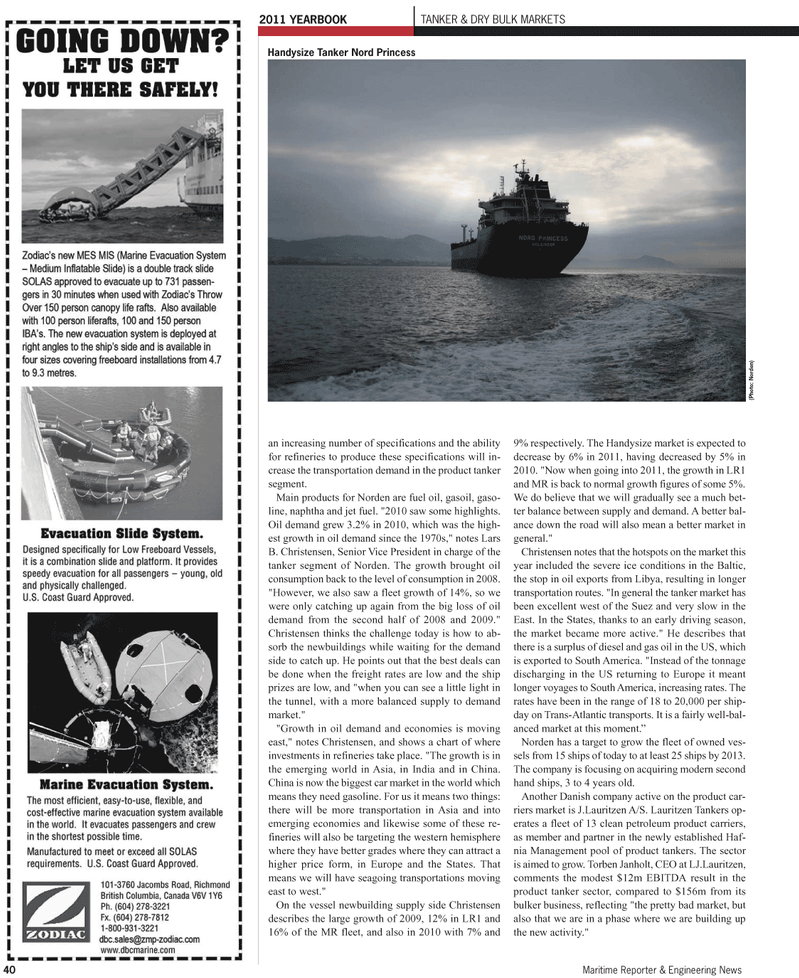
Page 44: of Maritime Reporter Magazine (June 2011)
Feature: Annual World Yearbook
Read this page in Pdf, Flash or Html5 edition of June 2011 Maritime Reporter Magazine
an increasing number of specifications and the ability for refineries to produce these specifications will in- crease the transportation demand in the product tanker segment. Main products for Norden are fuel oil, gasoil, gaso-line, naphtha and jet fuel. "2010 saw some highlights. Oil demand grew 3.2% in 2010, which was the high- est growth in oil demand since the 1970s," notes Lars B. Christensen, Senior Vice President in charge of the tanker segment of Norden. The growth brought oil consumption back to the level of consumption in 2008. "However, we also saw a fleet growth of 14%, so we were only catching up again from the big loss of oildemand from the second half of 2008 and 2009."Christensen thinks the challenge today is how to ab- sorb the newbuildings while waiting for the demand side to catch up. He points out that the best deals canbe done when the freight rates are low and the ship prizes are low, and "when you can see a little light in the tunnel, with a more balanced supply to demandmarket." "Growth in oil demand and economies is moving east," notes Christensen, and shows a chart of where investments in refineries take place. "The growth is in the emerging world in Asia, in India and in China. China is now the biggest car market in the world which means they need gasoline. For us it means two things: there will be more transportation in Asia and into emerging economies and likewise some of these re- fineries will also be targeting the western hemisphere where they have better grades where they can attract a higher price form, in Europe and the States. That means we will have seagoing transportations moving east to west." On the vessel newbuilding supply side Christensen describes the large growth of 2009, 12% in LR1 and 16% of the MR fleet, and also in 2010 with 7% and9% respectively. The Handysize market is expected to decrease by 6% in 2011, having decreased by 5% in 2010. "Now when going into 2011, the growth in LR1 and MR is back to normal growth figures of some 5%. We do believe that we will gradually see a much bet- ter balance between supply and demand. A better bal- ance down the road will also mean a better market in general." Christensen notes that the hotspots on the market this year included the severe ice conditions in the Baltic, the stop in oil exports from Libya, resulting in longer transportation routes. "In general the tanker market has been excellent west of the Suez and very slow in the East. In the States, thanks to an early driving season, the market became more active." He describes that there is a surplus of diesel and gas oil in the US, whichis exported to South America. "Instead of the tonnage discharging in the US returning to Europe it meant longer voyages to South America, increasing rates. The rates have been in the range of 18 to 20,000 per ship- day on Trans-Atlantic transports. It is a fairly well-bal- anced market at this moment.? Norden has a target to grow the fleet of owned ves- sels from 15 ships of today to at least 25 ships by 2013.The company is focusing on acquiring modern second hand ships, 3 to 4 years old.Another Danish company active on the product car- riers market is J.Lauritzen A/S. Lauritzen Tankers op- erates a fleet of 13 clean petroleum product carriers,as member and partner in the newly established Haf- nia Management pool of product tankers. The sector is aimed to grow. Torben Janholt, CEO at LJ.Lauritzen, comments the modest $12m EBITDA result in the product tanker sector, compared to $156m from its bulker business, reflecting "the pretty bad market, but also that we are in a phase where we are building up the new activity." 40Maritime Reporter & Engineering News 2011 YEARBOOKTANKER & DRY BULK MARKETS (Photo: Norden) Handysize Tanker Nord Princess

 43
43

 45
45
